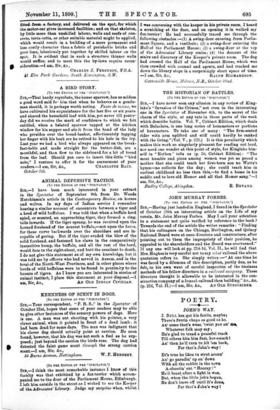[To THE EDITOR OF THE "SPECTATOR."]
SrE.,—The suggestion in your interesting article in the ,S'pectatoe of November 4th on the needs of a more economical form of cottage, leads me to suggest that we may learn some- thing from our predecessors, for it is a well-known fact that when in the early days of the Roman Empire the need arose for buildings on a great scale they developed a method of building which required the least amount of skilled labour, so that during the next three hundred years they were able, in all parts of the world under their sway, to erect buildings greater and more numerous than ever the world has known to be erected in the like period. The success of their method consisted in a complete mastery of the essentials of a hydraulic cement, and the organisation of unskilled labour under skilled direction. We have in Portland cement achieved a like cement. Contrary to other building materials, it every day becomes less in cost, but as yet no successful application of its qualities has been attained in small buildings. For this the model and other by-laws are to a certain extent responsible ; they practically ignore the advantages of hydraulic cement ; walls built of the poorest lime and of the highest standard of hydraulic mortar are to them alike, and required to be of like thick- ness. In the Roman manner of building, permanent skeleton centres on which the fabric was gradually built up formed a part of their system ; the like is found in England in the clay daubings and wattlework of the early cottages. In America framed skeleton buildings of iron have been largely adopted for the tall buildings to be found there. It appears to me that in this system lies the future of a less costly building of cottages. Instead of the oak framing resting on the ground of the primitive cottage, a light frame of metal, sufficient to form a skeleton, might be supplied completely fitted- frem-a factory, and delivered on the spot, for which the motor•car gives increased facilities; and on that skeleton, by little more than unskilled labour, walls and roofs of con- crete, terra-cotta, or other suitable material might be applied, which would result in a building of a more permanent and less costly character than a fabric of perishable bricks and poor lime, laboriously put together by skilled labour on the spot. It is evident that in such a structure thinner walls would suffice, and to meet this the by-laws require recon- sideration.—I am, Sir, &c.,











































 Previous page
Previous page